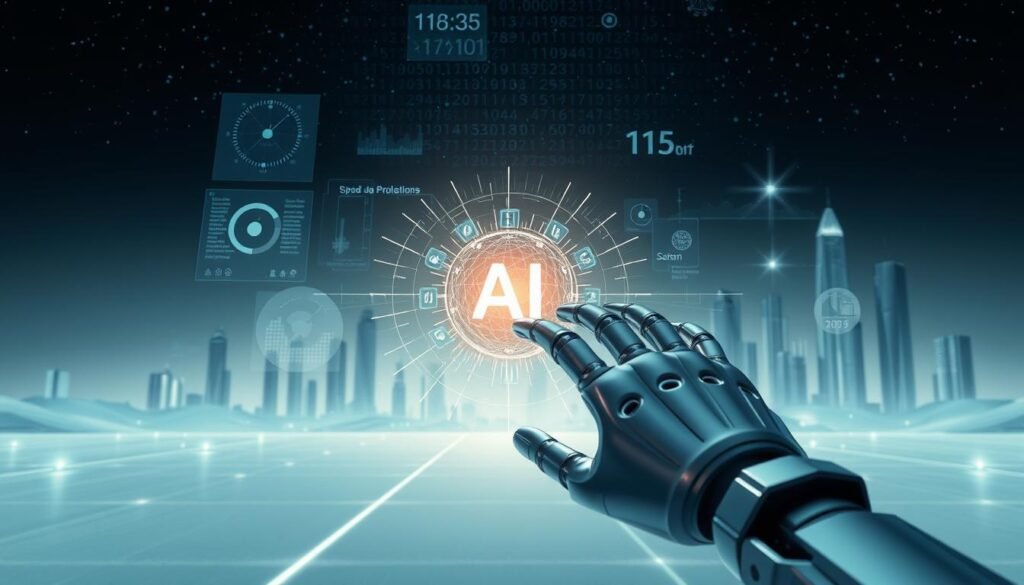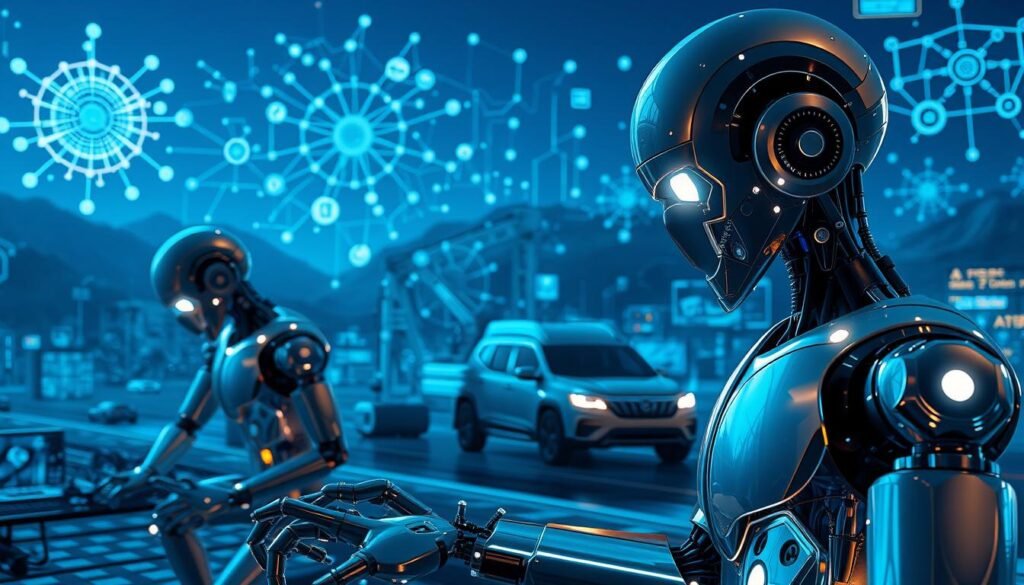Nearly 80% of U.S. companies reported using at least one form of this technology in 2024, showing how fast it has moved from labs into products that shape daily work.
This field brings together computers, statistics, linguistics, and neuroscience to build machines that reason and learn. It powers real services like OCR that turn images into business-ready data.
In this Ultimate Guide we will define key terms, map the core technologies, and explain how learning methods such as machine learning and deep learning drive analytics, recommendations, and smart retrieval.
Expect clear, practical coverage of common tasks — classification, translation, and conversational help — plus why data quality and robust pipelines are strategic assets for U.S. organizations.
Read on for actionable insights, concrete examples, and a balanced view of benefits and risks.
Key Takeaways
- The guide defines the term and shows how it underpins modern products and services.
- Data-driven learning and scalable systems turn raw content into measurable value.
- OCR and recommendation engines show practical applications today.
- Multidisciplinary roots matter for building reliable, real-world solutions.
- Future sections cover algorithms, models, evaluation, and responsible deployment.
Why Artificial Intelligence Matters Today
Cloud-scale compute and richer datasets have turned learning methods into reliable building blocks for modern products.
These advances let systems add intelligence to existing software, blending automation, conversational platforms, and smart machines with large amounts of data.
How AI became the backbone of modern computing
Cloud platforms, specialized silicon, and improved optimization made models production-ready. Mature learning techniques now deliver consistent performance and uptime.
The present landscape: from cloud systems to everyday apps
Businesses use models to cut errors, automate repetitive tasks, and run systems “always on” for real-time outcomes.
- Finance: anomaly detection for fraud.
- Healthcare: image recognition and robotics-assisted care.
- Consumer apps: personalized recommendations and neural translation.
| Domain | Common use cases | Primary benefit |
|---|---|---|
| Finance | Fraud detection, risk scoring | Faster, more accurate alerts |
| Healthcare | Image analysis, surgical assistance | Higher precision and reduced error |
| Media & Retail | Recommendations, personalization | Increased engagement and revenue |
| Logistics | Routing, demand forecasting | Lower costs and faster delivery |
Improved models help teams turn raw datasets into actionable solutions and measurable ROI. Recent research and engineering gains made this shift practical and cost-effective.
Next: we will define core terms and explain the mechanics that power these capabilities.
What Is Artificial Intelligence?
Put simply, it means building machines that can reason, learn from data, and perform complex tasks once reserved for humans.
Definition: artificial intelligence describes computer systems that simulate human problem solving, pattern recognition, and decision-making at scale.
How it relates to other approaches
Machine learning is the set of techniques that let systems learn from examples. Most production deployments use machine learning rather than general intelligence.
Deep learning scales representation learning with neural networks, improving accuracy on vision and speech problems.
Natural language processing focuses on text and speech. It powers chatbots, translation, and summarization using large language models.

- Examples: ChatGPT generates text, Google Translate performs neural translation, Netflix personalizes catalogs.
- Integration: models sit inside applications, supported by data pipelines and serving systems.
- Reality check: most solutions are narrow — optimized for specific tasks, not human-like generality.
Why definitions matter: clear terms guide strategy, governance, and risk management so teams set realistic goals and measure reliability.
How AI Works: Data, Algorithms, and Learning
Modern learning systems improve by finding statistical connections across very large collections of records.
The role of large amounts of data is simple: scale reveals patterns that handcrafted rules miss. With more examples, models generalize across varied inputs and edge cases.
The lifecycle of training and evaluation
Teams collect and clean datasets, then pick algorithms and train models on labeled or unlabeled examples. Evaluation uses held-out sets to measure error and reveal blind spots.
Iteration follows: tune loss functions, adjust regularization, and monitor validation trends to avoid overfitting.
Why deep networks improve accuracy
Deep learning stacks layers to learn hierarchical features. Backpropagation updates millions of parameters so networks capture complex relationships for vision and language tasks.
- Contrast: rule-based systems need explicit instructions; learned models infer rules from data.
- Engineering: feature stores, data versioning, and reproducible pipelines manage large amounts of data.
- Deployment: batch vs. real-time processing affects latency budgets and scaling strategies.
High-quality labels, balanced datasets, and drift detection keep model results reliable over time. Good data practices remain the fastest way to better solutions.
Types of Artificial Intelligence
Understanding how systems are grouped clarifies what they can and cannot do today.

Development stages
Reactive machines react to inputs with no memory of past events. A classic example is IBM Deep Blue, which evaluated board positions but did not learn across games.
Limited memory systems are the norm now. These machines use past data to inform short-term decisions, powering many production services for vision and language.
The last two stages—theory of mind and self-aware—remain research frontiers. They are theoretical and not present in deployed systems.
Capability spectrum
Artificial narrow intelligence (ANI) excels at specific tasks within constrained domains. Most commercial systems are ANI, optimized for clear objectives using large datasets.
By contrast, AGI would be able to sense, think, and act like humans. Superintelligence would surpass human ability. Neither AGI nor ASI exists today.
Strong vs. weak systems in practice
- Weak systems (ANI) run targeted workflows in production and require human oversight for edge cases.
- Strong systems (AGI) are a research goal; benchmarks and recognition remain debated among scholars and engineers.
“Benchmarks such as the Turing Test highlight imitation, but they do not fully define understanding or consciousness.”
Type distinctions matter for governance, safety, and investment. Clear categories help teams set oversight, assess risk, and separate marketing claims from measurable research progress.
Core Machine Learning Approaches and Neural Network Models
At the heart of modern prediction systems are a handful of learning approaches that guide model choice and design.
Fundamental approaches
Supervised learning maps labeled inputs to outputs for prediction and classification using training data.
Unsupervised methods find structure in unlabeled data, useful for clustering and anomaly detection.
Semi-supervised mixes both to leverage scarce labels. Reinforcement learning trains agents via rewards for decision-making in dynamic settings.
Common neural architectures
Deep feedforward networks use hidden layers to extract hierarchical features. Backpropagation adjusts weights to reduce error efficiently.
CNNs excel on images through convolution and pooling. RNNs and LSTMs capture sequences and long-range context in language and speech.
GANs pair a generator and discriminator to synthesize realistic outputs for augmentation and creative use.
Generative models and LLMs
Generative models and large language models learn statistical structure from vast corpora to produce coherent text, audio, or images on demand.
“Choose algorithms that match your data, latency needs, and explainability requirements.”
| Approach | Strength | Typical use |
|---|---|---|
| Supervised | High accuracy with labels | Classification, regression |
| Unsupervised | Discovers hidden structure | Clustering, anomaly detection |
| Reinforcement | Optimizes sequential decisions | Robotics, recommendation policies |
| Generative (GAN/LLM) | Creates realistic media | Content generation, augmentation |
Example: collect and clean data, pick an algorithm, train models, and evaluate with metrics aligned to the product goal. Monitor drift and retrain to keep results reliable over time.
Key Domains: NLP, Computer Vision, and Speech
Modern products use three core sensory domains—text, images, and audio—to interact with people and machines. Each domain relies on deep neural networks and large datasets to deliver real-time value.
Natural language processing and language models for text and content
Natural language processing enables systems to understand and generate text and dialogue. It powers chatbots, summarization, and translation that users see daily.
Language models capture semantic structure for retrieval, classification, and content generation across workflows. Google Translate is a common example of neural translation in production.
Computer vision for images, object detection, and inspection
Computer vision recognizes images, detects objects, and supports visual inspection in manufacturing and healthcare. Perception systems drive features like Tesla’s camera-based driving aids.
Techniques include detection, segmentation, and anomaly spotting. High-quality labels and domain adaptation matter for accuracy across environments.
Speech recognition and conversational AI for real-time interactions
Speech systems convert audio to text and enable real-time assistants, transcription, and voice interfaces. Products such as Alexa and Google Assistant use deep learning to improve accuracy.
Latency and reliability are critical for streaming inputs. On-device models and optimized pipelines reduce lag and boost uptime.
- Integration: combine domains in products for richer UX and tighter automation.
- Data matters: annotation quality and domain adaptation guide generalization.
Artificial intelligence Use Cases, Benefits, and Risks
Across industries, modern systems turn large amounts of data into practical services that cut costs and speed decisions.
Industry applications: finance, healthcare, manufacturing, and beyond
Finance uses models for fraud detection and risk scoring. Healthcare applies robotics and diagnostic support to assist clinicians.
Manufacturing relies on computer vision for inspection and digital twins to optimize production. OCR automates document workflows and extracts structured data from text and images.
Automation, reduced errors, and always-on systems
Benefits include automation of repetitive tasks, lower human error, and systems that run continuously in the cloud.
Scalable pipelines and learning algorithms find patterns that improve forecasting and processing at scale.
Bias, transparency, and cybersecurity considerations
Risks arise when training data embeds bias or when models act as opaque decision-makers. New attack surfaces target models and pipelines.
Trustworthy AI: ethical, equitable, and sustainable solutions
Trustworthy rollouts combine bias audits, model cards, incident response plans, and clear user transparency for automated decisions.
Practical deployments pair automation with human review on high-impact tasks to align system ability with organizational risk tolerance.
| Domain | Use case | Key benefit |
|---|---|---|
| Finance | Fraud detection, transaction scoring | Faster alerts, lower losses |
| Healthcare | Diagnostic support, surgical robotics | Improved accuracy, safer care |
| Manufacturing | Visual inspection, digital twins | Higher throughput, fewer defects |
| Enterprise | OCR, document automation | Faster processing, structured data |
Conclusion
Practical systems translate data into repeatable results that improve business operations and user experiences.
Key benefit: turning large datasets into products and solutions delivers measurable value across finance, healthcare, retail, and more.
Keep terms clear and match technologies to the problem. Use careful evaluation, governance, and human review so projects stay reliable and fair.
Invest in data quality, continuous learning, and scalable infrastructure to sustain performance over time. Follow research and iterate as capabilities evolve.
Act now: align teams, set success metrics, and start small with responsible pilots that show real benefits for stakeholders and humans affected.
FAQ
What does “Artificial Intelligence: Unlocking the Future” mean for businesses?
The phrase highlights how systems that mimic human thinking improve operations, products, and services. Companies use these technologies to automate routine tasks, enhance decision-making with data-driven models, and create new customer experiences across cloud platforms and mobile apps.
How did AI become the backbone of modern computing?
Advances in algorithms, larger datasets, and cheaper compute power transformed rule-based tools into adaptive systems. Today, models run in the cloud, on edge devices, and inside enterprise software, enabling real-time analytics, personalization, and automation at scale.
What is the difference between AI, machine learning, deep learning, and natural language processing?
AI is the broad field of making machines perform tasks that normally require human thought. Machine learning is a subset that uses data to train models. Deep learning uses layered neural networks to learn complex patterns. Natural language processing focuses on understanding and generating human language for tasks like summarization, translation, and chatbots.
Why do large amounts of data matter for these systems?
Data exposes patterns that models learn to generalize. More high-quality data helps models improve accuracy, detect rare events, and handle diverse inputs. Without sufficient data, models risk poor performance and bias.
How does the training, evaluation, and iteration cycle work?
Engineers split data into training, validation, and test sets. They train models on the training set, tune hyperparameters using validation results, and measure final performance on the test set. Teams iterate by collecting more data, refining architectures, or adjusting objectives to close gaps.
What role do neural networks and deep learning play in improving accuracy?
Deep networks with hidden layers can learn hierarchical features from raw inputs like text, images, or audio. This enables systems such as convolutional networks for vision and recurrent or transformer-based models for language to achieve strong results on complex tasks.
What are the main development stages of intelligent systems?
Systems range from reactive machines that respond to inputs, to limited memory models that use past data, up to theoretical constructs like theory of mind and self-aware systems. Most real-world deployments today use reactive or limited-memory designs.
How do narrow AI, AGI, and superintelligence differ?
Narrow AI solves specific tasks such as fraud detection or image classification. Artificial general intelligence (AGI) would match human versatility across domains. Superintelligence would exceed human ability. Current efforts focus primarily on narrow systems with domain-specific strengths.
What are the core machine learning approaches?
Common approaches include supervised learning (labeled data), unsupervised learning (discovering structure), semi-supervised learning (mix of labeled and unlabeled), and reinforcement learning (learning via rewards). Each fits different problem types and data availability.
Which neural network types are widely used and why?
CNNs excel at image tasks, RNNs and LSTM handle sequences, GANs generate realistic data, and deep feedforward networks serve many prediction tasks. Choice depends on data type and the problem, such as detection, generation, or classification.
Why are backpropagation and hidden layers important?
Backpropagation updates network weights by propagating errors backward, enabling learning. Hidden layers let models represent complex, non-linear relationships, which raises accuracy on sophisticated tasks compared with shallow models.
What are generative models and large language models used for?
Generative models create new content—images, sound, or text—while large language models produce and understand language for summarization, drafting, and conversational agents. They power tools like image synthesis and automated content creation.
How does natural language processing help businesses?
NLP enables sentiment analysis, automated support, document search, and content generation. It helps teams process large volumes of text, extract insights, and deliver personalized communication at scale.
What can computer vision do for industry applications?
Computer vision handles tasks like defect detection, object tracking, and visual inspection. Manufacturers use it for quality control; retailers use it for shelf monitoring; healthcare uses it for medical imaging analysis.
How is speech recognition and conversational AI applied?
Speech systems convert audio to text and enable voice-driven assistants for customer service and hands-free workflows. Conversational AI combines language models and dialogue management to support real-time interactions and automation.
What are common use cases across finance, healthcare, and manufacturing?
In finance, models power fraud detection and algorithmic trading. Healthcare uses predictive models for diagnostics and workflow optimization. Manufacturing benefits from predictive maintenance, process automation, and visual inspection systems.
What are the primary benefits of these technologies?
Benefits include automation of repetitive work, faster decision-making, reduced errors, and 24/7 system availability. They also enable new products and personalized customer experiences that scale efficiently.
What risks should organizations manage?
Key risks include biased outcomes, lack of transparency, and cybersecurity threats. Poor data or opaque models can harm users and brands. Teams must audit models, enforce governance, and secure data pipelines.
What does trustworthy development look like?
Trustworthy solutions focus on fairness, transparency, and sustainability. That means rigorous testing for bias, clear explanations for decisions, strong data protection, and continuous monitoring in production.
How can companies get started responsibly?
Start with clear goals, small pilots, and cross-functional teams including domain experts. Prioritize high-quality data, implement governance, and partner with reputable cloud providers or vendors for secure infrastructure and compliance support.



